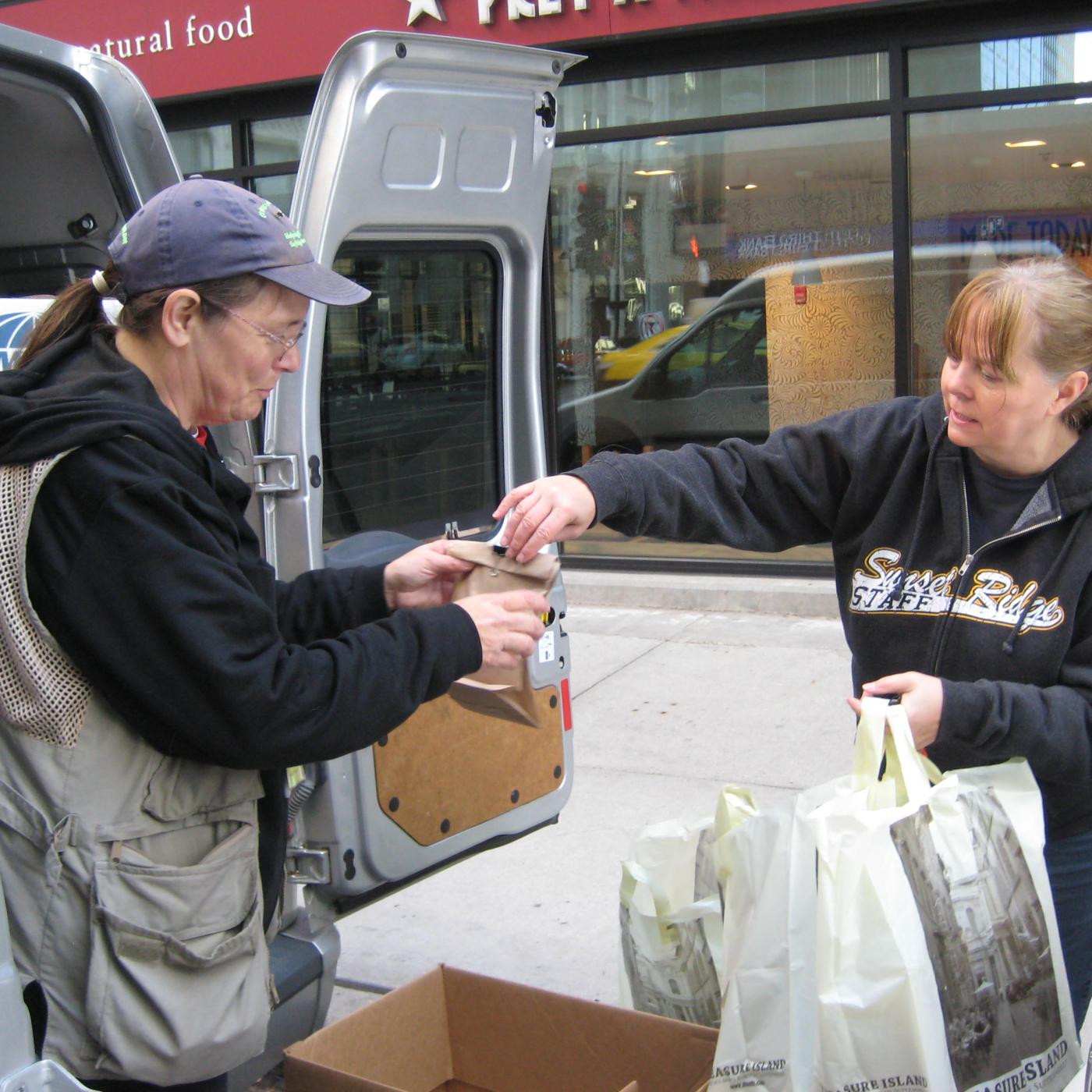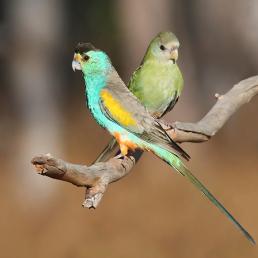

Join BirdNote tomorrow, November 30th!
Illustrator David Sibley and actor H. Jon Benjamin will face off in the bird illustration battle of the century during BirdNote's Year-end Celebration and Auction!
A Day Rescuing and Recovering Migrating Birds
-- With Annette Prince, Director of Chicago Bird Collision Monitors
Part I: Rescue – On the Streets of Downtown Chicago
Fall and spring, hundreds of thousands of migrating birds collide with glass buildings in downtown areas. On Sunday, October 21, 2012, BirdNote’s executive producer Chris Peterson trailed Annette Prince of Chicago Bird Collision Monitors – or CBCM - from dawn to dusk, to rescue and recover survivors in Chicago’s Loop. The monitors are all volunteers!


It’s barely light at 5:45 AM, and Annette is already on the streets of downtown Chicago searching for birds that have collided with glass. On this day, about 30 of the 50 birds she and the other volunteers will find are alive but stunned or injured; the others have died. Exhausted from migrating through the night, some have dropped into small city parks to rest and refuel, only to hit glass after flying to a tree that turns out to be only a reflection.

This morning, about ten of the group's 100 volunteers search for birds. Annette is in constant contact with them via cell phone. Soon, we cross paths with Mike, a science teacher, who’s found a junco that hit a window. When a downed bird is alive, it goes into a breathable brown paper bag; when it’s not, it goes into a plastic one, to be delivered to The Field Museum for their collection.



Annette receives a call on the (busy) Chicago Bird Collision Monitors hot-line. It’s from a building manager who wants us to come right over, so we head to Michigan Avenue. Annette uses her own vehicle for the CBCM rescues -- applying their logo while she's on the job. I wait by Annette’s van while she goes to retrieve the bird, a White-throated Sparrow.




When Annette sees a stunned bird, how does she catch it? She approaches from the side, so that should it try to fly again, it won’t crash into the window once more. Note the bird in the lower right hand corner of this photo.


Quickly and carefully, she places her net over the bird. Then she readies a paper bag into which she places the bird and make notes about it on the outside.


This bird turns out to be a Ruby-crowned Kinglet, migrating from somewhere in the boreal forest of Canada, along the shore of Lake Michigan, to the southern US, possibly headed for Mexico. As it is for many, the urban area is foreign habitat. If you look carefully, you can see its eye is bulging, which means it has suffered head trauma.

We find several birds by this building – which demonstrates three problems at once:
1) Glass reflects - thus, birds see trees that are not really there;
2) Glass is transparent - thus, birds think they can fly through to trees they see on the other side of the building or inside the lobby. Ironically, this particular building invites birds to fly into palm trees – trees familiar to birds that winter in the tropics.
3) And when glass is located near a small park that attracts birds, the combination of greenery and glass can mean a fatal attraction.
Gulls and crows have learned that stunned and injured birds are easy to attack and eat -- birds like Nashville Warblers, Hermit Thrushes, Dark-eyed Juncos, White-throated Sparrows, even large birds like Woodcocks and Virginia Rails.
Annette’s volunteers begin bringing in the birds they have picked up this morning.






The boxes in Annette’s van are beginning to fill with bags of live, but injured, birds.


The dead birds include this American Woodcock and Northern Flicker.


Before we leave this location, Annette sees a Brown Creeper that has hit the glass. Remember this bird, because, like the Ruby-crowned Kinglet, its story has a happy ending (see Part II).


It’s now about six hours later. We’re going to stop at one more building before we head west to Willowbrook Wildlife Rehabilitation and Education Center, in a nearby Chicago suburb. On the way, Annette spies a stunned junco lying in the road. It’s Sunday, so we do a U-turn in front of only a few cars. I can only imagine what this street is like on a weekday!

Millions of birds are on the move during fall and spring, many making the trip for the first time. Who among us has not gotten confused when in a new location? Who wouldn’t search out something familiar for a place to rest and get some food? Here in downtown Chicago, surrounded by skyscrapers, we discover a migrating Northern Saw-whet Owl trying to get some rest. Can you find him in the photo?

Although huge, the problem of birds colliding with glass buildings is, in Annette’s words “nearly invisible.” People don’t realize how big a problem it is because they’re not out on the streets to see what’s happening. American Bird Conservancy –- ABC -- estimates between 300 million to one billion birds are being killed or injured this way each year.
The ultimate solutions will come when architectural designs incorporate bird safety into the buildings. Chicago’s Aqua Tower, designed by Studio Gang Architects, provides a good example. Rather than presenting large areas of dangerous, uninterrupted reflective or transparent glass, the building has terraced balconies that give the building “visual noise,” or a presence that birds would fly around rather than being deceived into thinking they can fly toward or through.

In the meantime, there are several things we can do to reduce the problem.
Take for instance this lobby at 300 East Randolph – where birds and people are safer for being able to see the glass. Facility managers also moved the trees in the lobby away from the windows.


One of the most promising solutions is Ornilux Glass, which incorporates a UV pattern into it. Birds (because they can see UV) see a dense and impenetrable pattern of sticks. To us, (because we can’t see UV) the glass is perfectly clear.
You can learn more about what homeowners can do to make their glass more bird-friendly at the CBCM website and from American Bird Conservancy.
As Annette Prince says about the millions of birds that collide with buildings while migrating during spring and fall, “They’re amazing creatures. They deserve a better fate.”

Yes, we’re smiling in this photo, ‘cause that’s what you usually do for a photo (Chris on left, Annette on right).
But the problem is distressing. Please help us get the word out. You might even want to volunteer to help rescue and recover birds in your area. Many cities are encouraging the dimming of architectural and internal lights in skyscrapers during spring and fall, in order to help save migratory birds. These cities include Chicago, Boston, Washington, DC, the Twin Cities, Portland, OR, San Francisco, Toronto, and others. If your city doesn't yet support the Lights Out! program, encourage your city council to do so. The US Green Building Council has more information.
Learn more about Chicago Bird Collision Monitors. CBCM is under the umbrella of Chicago Audubon Society.
Now follow us to Willowbrook Wildlife Center to see what happens next with the birds that are alive. See Part II!

